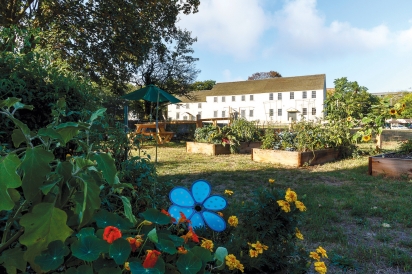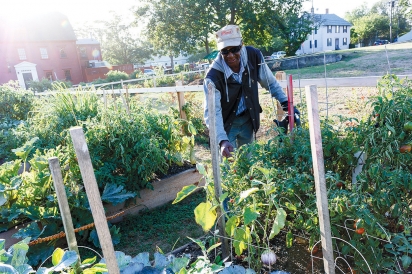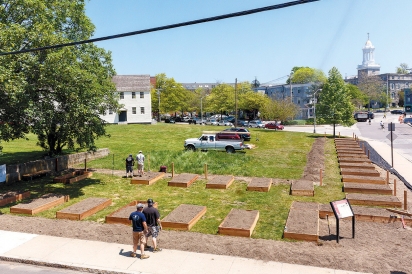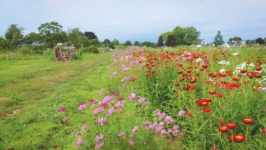Aquidneck Community Table and the Community Garden Project
In the Center of the City by the Sea, a Garden Grows
It’s a steamy Newport evening in early August, the time of year when tourists number in the tens of thousands and languages from around the world are heard in every bar and wharf. Yet in the city’s very center, at the intersection of Farewell and Marlborough streets, something distinctly local is happening on the lawn of the historic Great Friends Meeting House: a potluck.
Not just any potluck. This is the first meal shared among the first cohort of growers at Newport’s first community garden—and it’s delicious.
I help myself to the mid-summer abundance of fresh salads, zucchini muffins and other homemade delights, noting the curious looks of passersby. I can almost hear them think, “This wasn’t here before …”
From where I sit at one of the garden’s picnic tables, Newport’s diverse urban life is on display: the white tablecloth, historic White Horse Tavern, the nearby homeless shelter, a high-volume RIPTA bus stop, the hipster burger joint Mission, the cupola of Newport City Hall and, of course, the iconic Quaker Meeting House behind me. Just out of sight is the MLK Community Center, bustling Broadway with its restaurants and shops, baseball at Cardines Field, plus the homes representing every notch on the socioeconomic spectrum.
About 20 gardeners are here tonight representing the 23 (four- by eight-foot) plots that form a bountiful “L” shape on the southern edge of the expansive Meeting House green. The garden is surrounded by blueberry and raspberry bushes and enclosed by an attractive cedar and copper wire fence. Built by the nonprofit Aquidneck Community Table (ACT) on land owned by the Newport Historical Society (NHS), the garden was planned and designed with the utmost care for Newport’s aesthetics, history and community.
“The gardens have made the space more active and more integrated into the community,” writes NHS Executive Director Ruth Taylor in an email. “It is way more in the spirit of our Colonial ‘lively experiment’ to have activity on the property. The vast green space was very much a Colonial revival creation—based on a false idea that the past was quiet and pretty. Newport was very urban, even by the time this building was built in 1699. There were bustling people, gardens, animals and dirt.”
The Great Friends Meeting House is the oldest surviving house of worship in Rhode Island and was donated to NHS in the 1970s. In February 2016, the newly formed ACT approached Taylor about transforming part of the lawn as a space to grow food. Taylor said yes—if ACT could raise the money. And so a seed was planted.
PLANTING THE SEED
“Sometimes there’s an opportunity and you just need to figure out how to get it done,” says garden designer and planner Nikki Vasquez, a Newport resident and longtime instigator of garden projects at local schools. “Planning is important but doing something seals the deal. It’s hard to rally people behind concepts—but now here is a place in the center of our town that is a literal microcosm of our city. All kinds of people are going there; it’s unavoidable.”
With the blessing of NHS in February 2016, Vasquez and ACT Director Bevan Linsley needed to raise $30,000 to build the garden before the start of the growing season, just months away. “Thus began our wild ride,” says Linsley.
The group flew into fundraising mode—setting up an online GoFundMe campaign, throwing a party at a local restaurant, writing grants, gathering cash and in-kind donations from individuals and businesses and assembling volunteers. Suppliers and contractors like Liberty Cedar from South Kingstown sold materials at close to cost, and even showed up to volunteer on the build days. Newspaper interviews flowed in, and the shovels hit the dirt on Mother’s Day. They surpassed their goal. The extra funds helped purchase better fencing, a storage shed, and a small budget for the following season. By mid-May, there were 23 garden beds filled with rich compost to allocate to more than 45 applicants.
Choosing who would receive the plots “was certainly the hardest part,” says Linsley. Most beds went to individual Newport residents, whose dense city life often prevents growing food at home. Local businesses including Mission, the Tavern on Broadway, A Market, Newport Wine Cellar & Gourmet and NHS, itself, also rented spaces.
Although some detractors voiced concerns about the neighboring homeless population and the potential for theft, Vasquez says this is emblematic of the Newport that struggles with its identity as a city. “It’s a fight with itself,” she says with exasperation. “And a community garden is the symbol of that urban character—people don’t have the space to grow because it is a city.” As for theft? It hasn’t been a problem.
INCH BY INCH
With little time for garden planning and a record dry summer, the gardeners—many of them first-timers—had a tough row to hoe. “Watering every day is a big responsibility when it doesn’t rain ever,” laughs Vasquez. But as with all community gardens, the mix of growing experience and collective atmosphere helped make each plot productive. Back at the potluck, I had the chance to chat with many of these pioneering folks, whose diverse backgrounds and growing goals make this garden such a unique community space.
For some experienced growers like Kelsey Fitzgibbons and Astrid Spencer, the garden was a symbol of Newport’s progress. Having lived in and grown food in Oakland, California, and New Orleans, Louisiana, respectively, both reacted to the news of the downtown garden with, “finally!”
“Nothing like this really existed before, and I’m just excited that it’s here now,” says Fitzgibbons, who is growing green beans, cauliflower, Swiss chard, kale, onions, carrots, celery, lettuce and “maybe a few other things” in her plot.
Spencer adds how gardening is easier than beginners may think. “Plant it and it will grow,” she says, “And you’ll have fresh organic stuff that you won’t have to pay a fortune for. Whatever you grow yourself tastes a thousand times better than what you can buy—there’s that love aspect in it.”
Some foreign-born gardeners, like Therese Schulze of Germany and Cherayne Walker of Bequia, say the community garden reminds them of home.
“Back in the day, growing food—that’s the way it was done,” Walker says of her Caribbean roots. “It’s natural because my daughter Autumn has soy allergies, so it’s a good way of growing our own food without having to worry. And it’s nice to meet different people, plus a lot of people are giving comments and suggestions.”
For longtime Aquidneck Islanders like Trip and Christina Wolfskehl, it’s adding a whole new dimension to Newport life. “The garden project has changed my wife’s life totally—she’s now ‘Earth Mama,’” remarks Trip. “It’s her first time gardening and it’s been fun to see the transition. It’s a great destination for us and our kids on our bikes because it’s a nice protected area. We love it.”
LOOKING AHEAD
With twice as many applicants as there were garden plots, a demand for growing space is pervasive in the City by the Sea. According to Linsley and Vasquez, ACT is investigating ways to expand its community garden initiative with NHS and other local partners. Eventually, Vasquez says, she would like to see the gardens used for educational outreach and summer camps like the programs at Thomas Jefferson’s Monticello estate in Virginia. The close proximity of the MLK Center and Thompson Middle School could make this dream a reality.
Gardening is playing an important role in NHS’s Newport Eats initiative, an investigation of Newport’s culinary past through public lectures, exhibits and other interactive programming. Taylor explains how “people in Newport certainly grew their own food in 1699. But they also bought bread from bakers, and citrus fruit, sugar and spices from the tropics from merchants. And because we were relentless international traders, people were pretty sophisticated about food early on. We hope to get our audiences to think about food from past, present and the challenges of its future. History may offer us some helpful information.”
Tonight, I’ll keep chewing on the present moment and a mouthful of fresh vegetables, harvested right here on the corner of Marlborough and Farewell. It tastes sweet and salty, just like life in Newport.
To learn more about Aquidneck Community Table and/or apply for a garden bed, visit AquidneckCommunityTable.org.
To learn more about the Newport Historical Society and its 2017 Newport Eats programming, visit NewportHistory.org.










